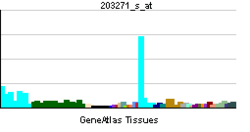Protein unc-119 homolog
| View/Edit Human | View/Edit Mouse |
Protein unc-119 homolog A is a protein that in humans is encoded by the UNC119 gene.[3][4][5]
Function
This gene is enriched in the photoreceptors of the retina. The encoded product shares strong homology with the C. elegans unc119 protein and it can functionally complement the C. elegans unc119 mutation. It has been localized to the photoreceptor synapses in the outer plexiform layer of the retina, and suggested to play a role in the mechanism of photoreceptor neurotransmitter release through the synaptic vesicle cycle. Two transcript variants encoding different isoforms have been described for this gene.[5]
Interactions
Protein unc-119 homolog has been shown to interact with:
References
- ↑ "Human PubMed Reference:".
- ↑ "Mouse PubMed Reference:".
- ↑ Higashide T, Murakami A, McLaren MJ, Inana G (Mar 1996). "Cloning of the cDNA for a novel photoreceptor protein". J Biol Chem. 271 (3): 1797–804. doi:10.1074/jbc.271.3.1797. PMID 8576185.
- ↑ Higashide T, McLaren MJ, Inana G (Apr 1998). "Localization of HRG4, a photoreceptor protein homologous to Unc-119, in ribbon synapse". Invest Ophthalmol Vis Sci. 39 (5): 690–8. PMID 9538874.
- 1 2 "Entrez Gene: UNC119 unc-119 homolog (C. elegans)".
- ↑ Kobayashi A, Kubota S, Mori N, McLaren MJ, Inana G (Jan 2003). "Photoreceptor synaptic protein HRG4 (UNC119) interacts with ARL2 via a putative conserved domain". FEBS Lett. 534 (1-3): 26–32. doi:10.1016/S0014-5793(02)03766-3. PMID 12527357.
- ↑ Stelzl U, Worm U, Lalowski M, Haenig C, Brembeck FH, Goehler H, Stroedicke M, Zenkner M, Schoenherr A, Koeppen S, Timm J, Mintzlaff S, Abraham C, Bock N, Kietzmann S, Goedde A, Toksöz E, Droege A, Krobitsch S, Korn B, Birchmeier W, Lehrach H, Wanker EE (Sep 2005). "A human protein-protein interaction network: a resource for annotating the proteome". Cell. 122 (6): 957–68. doi:10.1016/j.cell.2005.08.029. PMID 16169070.
- ↑ Van Valkenburgh H, Shern JF, Sharer JD, Zhu X, Kahn RA (Jun 2001). "ADP-ribosylation factors (ARFs) and ARF-like 1 (ARL1) have both specific and shared effectors: characterizing ARL1-binding proteins". J. Biol. Chem. 276 (25): 22826–37. doi:10.1074/jbc.M102359200. PMID 11303027.
- 1 2 3 4 Gorska MM, Stafford SJ, Cen O, Sur S, Alam R (Feb 2004). "Unc119, a novel activator of Lck/Fyn, is essential for T cell activation". J. Exp. Med. 199 (3): 369–79. doi:10.1084/jem.20030589. PMC 2211793
 . PMID 14757743.
. PMID 14757743. - 1 2 Cen O, Gorska MM, Stafford SJ, Sur S, Alam R (Mar 2003). "Identification of UNC119 as a novel activator of SRC-type tyrosine kinases". J. Biol. Chem. 278 (10): 8837–45. doi:10.1074/jbc.M208261200. PMID 12496276.
- ↑ Alpadi K, Magupalli VG, Käppel S, Köblitz L, Schwarz K, Seigel GM, Sung CH, Schmitz F (2008). "RIBEYE recruits Munc119, a mammalian ortholog of the Caenorhabditis elegans protein unc119, to synaptic ribbons of photoreceptor synapses". J. Biol. Chem. 283 (39): 26461–7. doi:10.1074/jbc.M801625200. PMC 3258921
 . PMID 18664567.
. PMID 18664567.
Further reading
- Swanson DA, Chang JT, Campochiaro PA, et al. (1998). "Mammalian orthologs of C. elegans unc-119 highly expressed in photoreceptors". Invest. Ophthalmol. Vis. Sci. 39 (11): 2085–94. PMID 9761287.
- Higashide T, Inana G (1999). "Characterization of the gene for HRG4 (UNC119), a novel photoreceptor synaptic protein homologous to unc-119". Genomics. 57 (3): 446–50. doi:10.1006/geno.1999.5791. PMID 10329014.
- Van Valkenburgh H, Shern JF, Sharer JD, et al. (2001). "ADP-ribosylation factors (ARFs) and ARF-like 1 (ARL1) have both specific and shared effectors: characterizing ARL1-binding proteins". J. Biol. Chem. 276 (25): 22826–37. doi:10.1074/jbc.M102359200. PMID 11303027.
- Strausberg RL, Feingold EA, Grouse LH, et al. (2003). "Generation and initial analysis of more than 15,000 full-length human and mouse cDNA sequences". Proc. Natl. Acad. Sci. U.S.A. 99 (26): 16899–903. doi:10.1073/pnas.242603899. PMC 139241
 . PMID 12477932.
. PMID 12477932. - Cen O, Gorska MM, Stafford SJ, et al. (2003). "Identification of UNC119 as a novel activator of SRC-type tyrosine kinases". J. Biol. Chem. 278 (10): 8837–45. doi:10.1074/jbc.M208261200. PMID 12496276.
- Kobayashi A, Kubota S, Mori N, et al. (2004). "Photoreceptor synaptic protein HRG4 (UNC119) interacts with ARL2 via a putative conserved domain". FEBS Lett. 534 (1–3): 26–32. doi:10.1016/S0014-5793(02)03766-3. PMID 12527357.
- Ota T, Suzuki Y, Nishikawa T, et al. (2004). "Complete sequencing and characterization of 21,243 full-length human cDNAs". Nat. Genet. 36 (1): 40–5. doi:10.1038/ng1285. PMID 14702039.
- Gerhard DS, Wagner L, Feingold EA, et al. (2004). "The Status, Quality, and Expansion of the NIH Full-Length cDNA Project: The Mammalian Gene Collection (MGC)". Genome Res. 14 (10B): 2121–7. doi:10.1101/gr.2596504. PMC 528928
 . PMID 15489334.
. PMID 15489334. - Stelzl U, Worm U, Lalowski M, et al. (2005). "A human protein-protein interaction network: a resource for annotating the proteome". Cell. 122 (6): 957–68. doi:10.1016/j.cell.2005.08.029. PMID 16169070.
- Rual JF, Venkatesan K, Hao T, et al. (2005). "Towards a proteome-scale map of the human protein-protein interaction network". Nature. 437 (7062): 1173–8. doi:10.1038/nature04209. PMID 16189514.
- Vepachedu R, Gorska MM, Singhania N, et al. (2007). "Unc119 regulates myofibroblast differentiation through the activation of Fyn and the p38 MAPK pathway". J. Immunol. 179 (1): 682–90. doi:10.4049/jimmunol.179.1.682. PMID 17579091.
This article is issued from Wikipedia - version of the 6/5/2016. The text is available under the Creative Commons Attribution/Share Alike but additional terms may apply for the media files.
